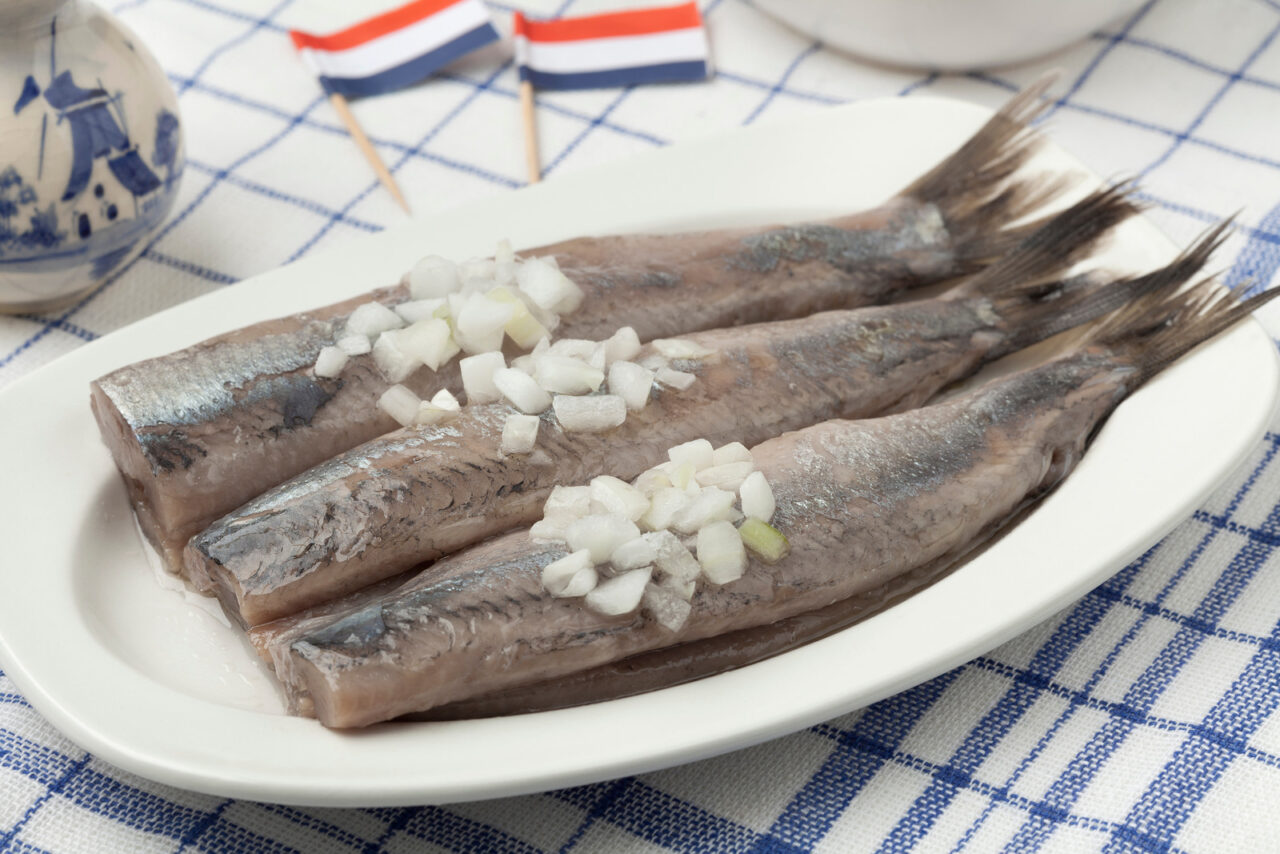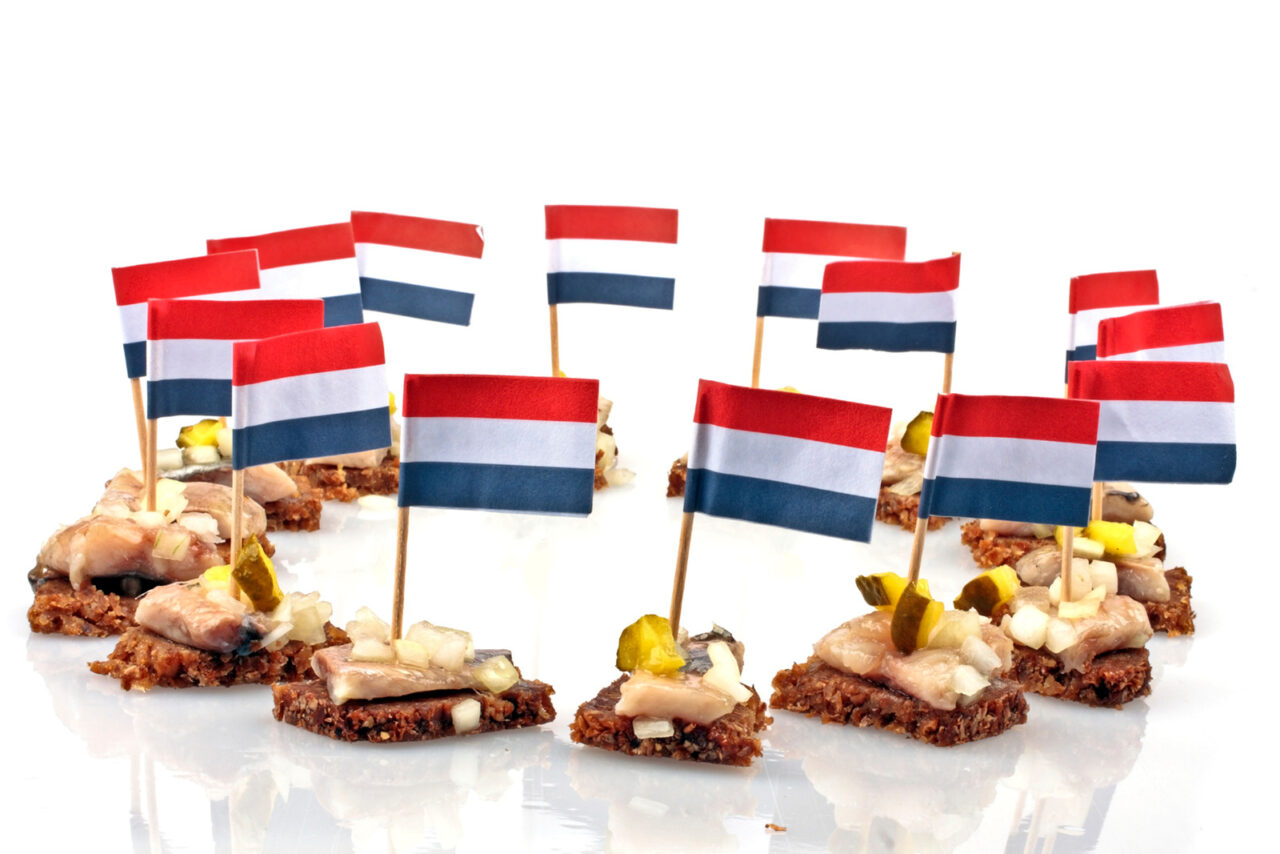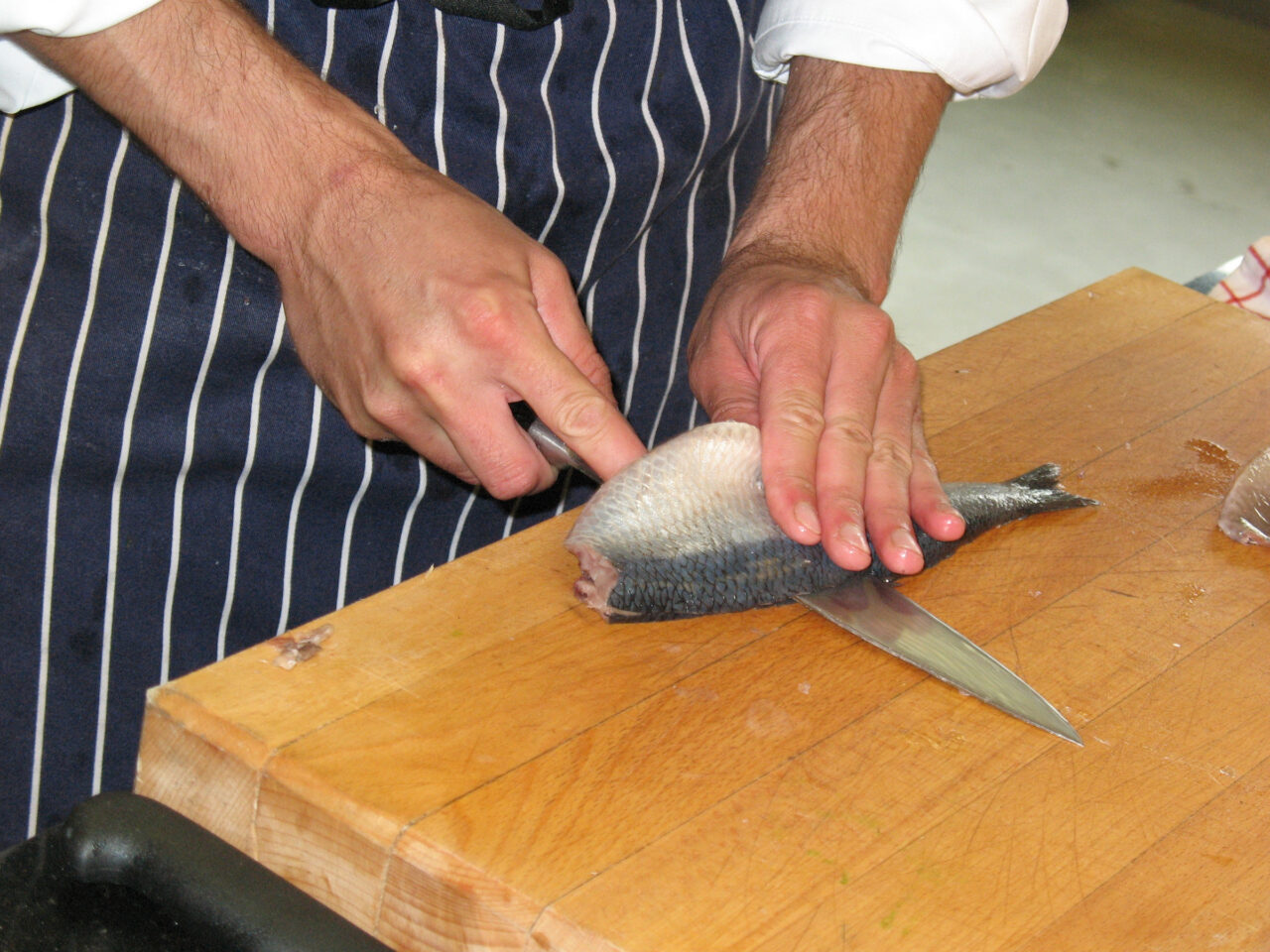Nederlands
English
Deutsch
Français
In mid-June, the time has come again: the New Herring, otherwise known as Hollandse Nieuwe, a traditional Dutch product. The first herring keg is auctioned on Flag Day, and a little later the sale of the Hollandse Nieuwe begins in all fishmongers on the same day. There are even herring parties and other events taking place.
Where does this tradition of the Hollandse Nieuwe come from? And what exactly does the process of this New Herring and all other herring products entail?
In this article, we will discuss the origin of the Hollandse Nieuwe and the popular herring tradition in the Netherlands. Besides the traditional fresh salted herring with onions and pickles, the various sour and smoked herring products will also be extensively discussed.
Topics discussed in this article:
What is the Hollandse Nieuwe?
Many people think that the Hollandse Nieuwe is another name for herring, but this is not entirely true. The Hollandse Nieuwe is an old traditional name for the product that is caught from mid-May and sold until September 30 of the same year.

All herrings that are sold after September 30 – and have therefore been frozen for longer than a certain time – are officially no longer covered by the name ‘Hollandse Nieuwe’, but must be sold under the name ‘Hollandse maatjesharing’ (soused herring or matjes). The name ‘maatje’ comes from the word ‘maagd’ in Dutch, which means virgin, so the Hollandse maatjesharing are young virgin herring. Since January 2016, the Hollandse Nieuwe has been awarded the EU designation ‘Guaranteed Traditional Specialty‘. This means that the product has a particularly traditional character due to its composition or method of preparation. This puts the Hollandse Nieuwe in the ranks of, for example, Dutch ‘Boerenkaas’, castor sugar and Serrano ham.
Vlaggetjesdag, the Dutch word for Flag Day, has existed since 1781 and was originally the day on which fishing boats, completely decorated with flags, were in the harbour on the Saturday before the first boats went out to fish for the Hollandse Nieuwe.
Since 1947, Flag Day has been celebrated on the day the new herring catch arrives. Every year, the boats in the ports of Scheveningen, Vlaardingen and IJmuiden are decorated with the Dutch red, white and blue flags and the first herring barrel is auctioned on this day. Nowadays, the traditional festival is mainly intended as a promotion for the sale of the New Herring.

In 2019, the first herring keg yielded no less than € 95,500. Last year, Flag Day was cancelled due to the corona crisis. Nevertheless, the port of Scheveningen was decorated with many flags and as usual, the Mayor received the first herring keg, which was donated to the IC staff of the Erasmus MC Hospital.
The official start of the New Herring is determined by the Dutch Visbureau, a public relations and marketing agency for the entire Dutch fish sector. The starting date depends on the quality of the fish: does the herring have a certain percentage of fat to start the catch?
New herring has a fat percentage of at least 16% and is caught before it has developed any soft or hard roe. When it is a nice and warm spring, the herring usually meets the right conditions. However, if it remains cold for a long time, there is a chance that the herring is not yet fat enough, resulting in the postponement of the fish catch. This happened in 2013 and 2015.Catch of the (new) herring
Although the Hollandse Nieuwe is a real Dutch tradition, the herring is no longer caught in the Netherlands. Our herring comes from the North Sea, mainly from Scotland, Norway and Denmark. The Dutch herring fleet only consists of two ships, so it is mainly the Norwegians and the Danes who provide us with our herrings. However, the herrings are prepared in the Dutch way by Dutch companies, which is why they are still called Hollandse Nieuwe.
The Dutch herring fishing has taken an exemplary position in Europe in terms of sustainability. There is an annual herring quota for catching herring: the maximum amount of herring to be caught is determined each year on the basis of scientific research and advice. This is extremely important for the conservation of this popular North Sea fish.
In 2020, no less than 385,008 tons of North Sea herring were caught. About 25,000 tons (25 million kilos) of this was processed into Hollandse Nieuwe. This is a total of about 180 million herrings. These New Herrings were not only consumed in the Netherlands. On the contrary: no less than 50% went to Germany and 7.5% was exported to Belgium.
The remaining quantity of North Sea herring is not New Herring, but is processed into smoked herring or tinned herring, such as rollmops (collared herring), pickled herring and fried herring.
It is often said and thought that herring is raw fish, but this is not entirely true either. Herrings are aged in brine. Immediately after capture, they are first processed. The gills and entrails are removed from the herring. The pancreas is the only thing that remains, allowing the herring to continue to ripen during the brining and ultimately taste better.

The pickled herrings are then placed in barrels, trays or vacuum-drawn bags. The salt ensures that the moisture is extracted from the herring and the herring becomes saltier. The more salt, the longer the herring continues to mature and the longer the herring is edible.
By freezing the herrings, the ripening process is stopped. This was of course not possible in the past, so much more salt was used at the time to conserve the herring. This made the herrings much saltier, which is why they were consumed with a chopped onion. This tradition has always remained, although the herring is also often eaten with pickles or completely natural.
Nowadays, herrings are frozen directly and the Hollandse Nieuwe must have been frozen for at least 24 hours before selling and consuming. This ensures that any parasites in the herring are killed. Pickled herring and smoked herring
Of the total allowable catch (385,008 tons of North Sea herring in 2020), ‘only’ one-twentieth part is used for processing into Hollandse Nieuwe. This well reflects the enormous popularity of all other herring products: more than 360,000 tons of herring are processed into smoked herring (in Dutch: spekbokking) or tinned and preserved herring.
The market for tinned herring is especially large. Think of the well-known cans of herring in tomato sauce, pickled herring fillet pieces (herring marinated in acid), pan herring or roast herring (fried herring in vinegar), bake smoked herring (slightly smoked herring for baking/frying), smoked herring or smoked herring fillet. But herring can also be used in salads, such as the pickled herring and beetroot salad or the herring in dill sauce, delicious with a salad or on bread.
Curious about Mooijer-Volendam’s entire herring range? Mooijer-Volendam sells diverse herring products: from fresh salty herrings to smoked herrings and pickled herrings.
Of course, all the above-mentioned herring products, and even more, are for sale at Mooijer-Volendam. As a herring buyer, you have come to the right place. As a herring wholesaler, Mooijer-Volendam sets high standards for its quality. Our customers can rely on AAA product quality, which is what customers demand from us.
This is why more and more customers know how to find us as a catering wholesaler or as a wholesaler for fishmongers, Oriental stores, speciality stores and large retailers.